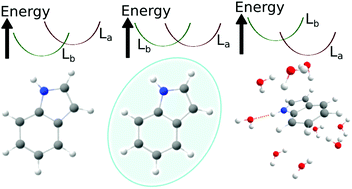The quantum chemical solvation of indole: accounting for strong solute–solvent interactions using implicit/explicit models†
Abstract
In this paper, we investigate the efficacy of different quantum chemical solvent modelling methods of indole in both water and methylcyclohexane solutions. The goal is to show that one can yield good photophysical properties in strongly coupled solute–solvent systems using standard DFT methods. We use standard and linearly-corrected Polarisable Continuum Models (PCM), as well as explicit solvation models, and compare the different model parameters, including the choice of density functional, basis set, and number of explicit solvent molecules. We demonstrate that implicit models overestimate energies and oscillator strengths. In particular, for indole–water, no level inversion is observed, suggesting a dielectric medium on its own is insufficient. In contrast, energies are seen to converge fairly rapidly with respect to cluster size towards experimentally measured properties in the explicit models. We find that the use of B3LYP with a diffuse basis set can adequately represent the photophysics of the system with a cluster size of between 9–12 explicit water molecules. Sampling of configurations from a molecular dynamics simulation suggests that the single point results are suitably representative of the solvated ensemble. For indole–water, we show that solvent reorganisation plays a significant role in stabilisation of the excited state energies. It is hoped that the findings and observations of this study will aid in the choice of solvation model parameters in future studies.



 Please wait while we load your content...
Please wait while we load your content...